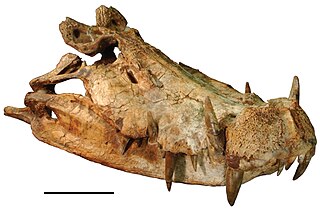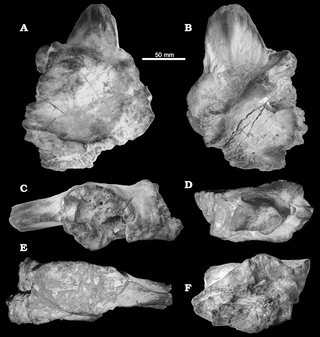
Rebbachisaurus is a genus of sauropod dinosaur of the superfamily Diplodocoidea, that lived during the Late Cretaceous period in Africa and possibly also South America about 99-97 million years ago. Remains attributed to Rebbachisaurus have been found in Morocco, Niger, Algeria, Tunisia and possibly also Argentina, although only the Moroccan remains can be referred to the genus without doubt. The discovery of Rayososaurus, a South American sauropod nearly identical to Rebbachisaurus which may have actually have been the same animal as Rebbachisaurus, supports the theory that there was still a land connection between Africa and South America during the Early Cretaceous, long after it was commonly thought the two continents had separated.
René Lavocat was a French palaeontologist who described several genera of African dinosaurs including the sauropod Rebbachisaurus, as well as several extinct mammals such as the family Kenyamyidae. The mammal Lavocatia, the notosuchian Lavocatchampsa, the sauropod Lavocatisaurus and the phorusrhacid Lavocatavis are named after him.

Notosuchia is a suborder of primarily Gondwanan mesoeucrocodylian crocodylomorphs that lived during the Jurassic and Cretaceous. Some phylogenies recover Sebecosuchia as a clade within Notosuchia, others as a sister group ; if Sebecosuchia is included within Notosuchia its existence is pushed into the Middle Miocene, about 11 million years ago. Fossils have been found from South America, Africa, Asia, and Europe. Notosuchia was a clade of terrestrial crocodilians that evolved a range of feeding behaviours, including herbivory (Chimaerasuchus), omnivory (Simosuchus), and terrestrial hypercarnivory (Baurusuchus). It included many members with highly derived traits unusual for crocodylomorphs, including mammal-like teeth, flexible bands of shield-like body armor similar to those of armadillos (Armadillosuchus), and possibly fleshy cheeks and pig-like snouts (Notosuchus). The suborder was first named in 1971 by Zulma Gasparini and has since undergone many phylogenetic revisions.

Peirosauridae is a Gondwanan family of mesoeucrocodylians that lived during the Cretaceous period. It was a clade of terrestrial crocodyliforms that evolved a rather dog-like skull, and were terrestrial carnivores. It was phylogenetically defined in 2004 as the most recent common ancestor of Peirosaurus and Lomasuchinae and all of its descendants. Lomasuchinae is a subfamily of peirosaurids that includes the genus Lomasuchus.

The Kem Kem Group is a geological group in the Kem Kem region of eastern Morocco, whose strata date back to the Cenomanian stage of the Late Cretaceous. Its strata are subdivided into two geological formations, with the lower Ifezouane Formation and the upper Aoufous Formation, with the Gara Sbaa Formation and Douira Formation used in the southern Tafilalt region. It is exposed on an escarpment along the Algeria–Morocco border.
Stolokrosuchus is an extinct genus of crocodyliforms that lived during the Early Cretaceous. Its fossils, including a skull with a long thin snout and bony knobs on the prefrontal, have been found in Niger. Stolokrosuchus was described in 2000 by Hans Larsson and Boubacar Gado. The type species is S. lapparenti. They initially described it as related to Peirosauridae, if not a member of that family. One study has shown it to be related to Elosuchus. However, more recent works usually find Stolokrosuchus to be one of the basalmost neosuchian, only distantly related to the elosuchid or pholidosaurid, Elosuchus. It was a semiaquatic crocodylomorph.

Hamadasuchus is an extinct genus of sebecian crocodylomorph. Fossils have been found from the Kem Kem Formation outcropping in southeastern Morocco. These beds date back to the Albian and Cenomanian stages of the Late Cretaceous. It was first assigned to the family Trematochampsidae. Diagnostic features of the genus include its lateromedially compressed and serrated teeth. It was deep-snouted and had a slightly heterodont dentition with three distinct tooth morphologies present from sections of the lower jaw.
Kemkemia is a genus of probable crocodyliforms living in the Cretaceous, described from a single fossil that was recovered in 1999 from Morocco by an Italian team searching for fossil invertebrates. The fossil of Kemkemia dates from the Cenomanian age.

Kaprosuchus is an extinct genus of mahajangasuchid crocodyliform. It is known from a single nearly complete skull collected from the Upper Cretaceous Echkar Formation of Niger. The name means "boar crocodile" from the Greek κάπρος, kapros ("boar") and σοῦχος, soukhos ("crocodile") in reference to its unusually large caniniform teeth which resemble those of a boar. It has been nicknamed "BoarCroc" by Paul Sereno and Hans Larsson, who first described the genus in a monograph published in ZooKeys in 2009 along with other Saharan crocodyliformes such as Anatosuchus and Laganosuchus. The type species is K. saharicus.
Mahajangasuchidae is an extinct family of notosuchian crocodyliforms. It currently contains two genera, Mahajangasuchus and Kaprosuchus, both of which lived during the Late Cretaceous in Gondwana. It is defined as the most inclusive clade containing Mahajangasuchus insignis but not Notosuchus terrestris, Simosuchus clarki, Araripesuchus gomesii, Baurusuchus pachecoi, Peirosaurus torminni, Goniopholis crassidens, Pholidosaurus schaumbergensis, or Crocodylus niloticus. Phylogenetically, Mahajangasuchidae is placed just outside pholidosaurids and more derived neosuchians.
The Al-Khod Conglomerate is a Mesozoic geologic formation in Oman. Dinosaur remains belonging to ornithischians, theropods and sauropods are among the fossils that have been recovered from the formation, although none have yet been referred to a specific genus, which belong to one of very few records of dinosaur remains currently known from Oman.

Campinasuchus is an extinct genus of baurusuchid mesoeucrocodylian from Minas Gerais State of Brazil.

Sauroniops is a controversial genus of carnivorous basal carcharodontosaurid theropod dinosaur known from the Late Cretaceous Gara Sbaa Formation, and possibly also the Kem Kem Formation, both of Morocco. The type, and currently only, species is S. platytholus.
Rukwasuchus is an extinct genus of peirosaurid crocodyliforms known from the middle Cretaceous Galula Formation of southwestern Tanzania. It contains a single species, Rukwasuchus yajabalijekundu.

Afrotapejara is an extinct genus of tapejarid pterosaur discovered in Morocco. The type species, Afrotapejara zouhri, was named and described in 2020. It was the first tapejarid discovered in Africa and the fourth pterosaur discovered in the Kem Kem Beds.

Apatorhamphus is an extinct genus of azhdarchoid pterosaur from the Kem Kem Group of Morocco. It might have been part of the Chaoyangopteridae. It is only known from a few snout fragments and it likely had a wingspan of between 3–7 metres (9.8–23.0 ft)

Nicorhynchus is a genus of anhanguerid pterosaur from the Cretaceous period. It contains two species, the type species, N. capito, from the Cambridge Greensand of England, and N. fluviferox from the Kem Kem Group of Morocco. These species were previously assigned to Coloborhynchus.

Lapparentophis is an extinct genus of terrestrial ophidian known from the Kem Kem Beds of Northwestern Africa that was first described by Robert Hoffstetter in 1959. Two species are known: the type species, L. defrennei from Algeria, and a second species, L. ragei from Morocco, which is only known from the holotype MHNM.KK387 and the paratype MHNM.KK388, two isloated trunk vertebrae.

Antaeusuchus taouzensis is a species of peirosaurid notosuchian from the Late Cretaceous Kem Kem Group of Morocco. It was described in 2021, and it is the only species in the genus Antaeusuchus. It is the fourth notosuchian described from the region and the second Kem Kem peirosaurid after Hamadasuchus. A 2023 study proposes that Antaeusuchus may not be distinct enough to warrant its own genus and that it instead represents another species of Hamadasuchus.
Barrosasuchus is a genus of peirosaurid notosuchian from the Santonian of Argentina and part of the extensive peirosaurid record of Late Cretaceous Patagonia. It contains one species, Barrosasuchus neuquenianus. B. neuquenianus is known from an almost complete skull and the majority of the articulated postcranial skeleton, making it the best preserved Patagonian peirosaurid.












